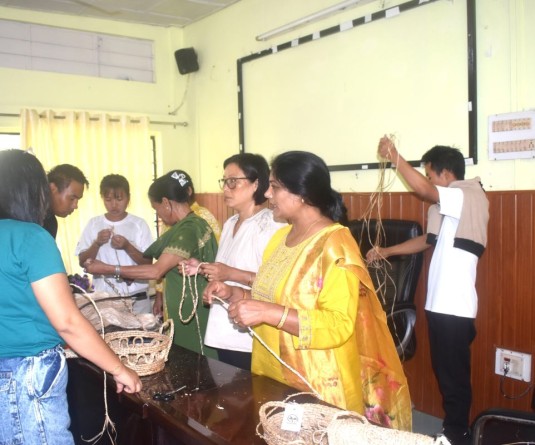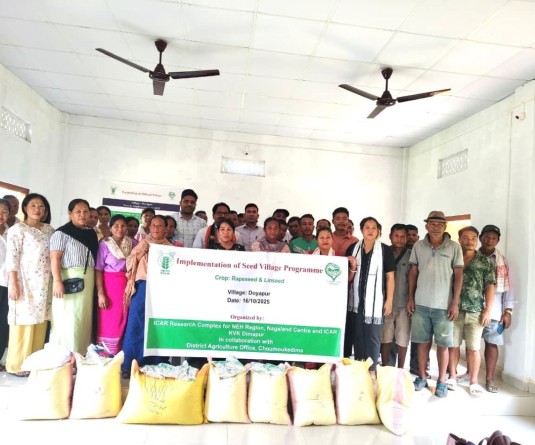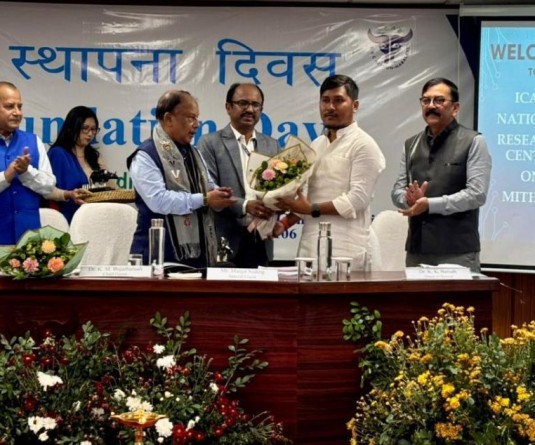
Plant Breeding & Genetics –Harendra Verma
Field Preparation and Nutrient Management
1. Apply well-decomposed FYM @3-5 tons/ha to improve soil structure and microbial activity.
2. Apply biofertilizers (eg., Azospirillum, PSB) during sowing or transplanting.
3. In Jhum (upland) areas, apply agricultural lime @ 200-400 kg/ha to correct soil acidity.
4. Conduct soil testing before sowing to guide nutrient management.
5. Clean field boundaries and remove alternate weed hosts to reduce pest/ disease pressure.
Seed and Variety Selection
1. Procure quality seeds from reliable sources to ensure genetic purity and vigor.
2. Recommended varieties:
• Rice: Bhalum-3, Bhalum-4, Bhalum-5 (suitable for hill ecosystems)
• Green gram: Pratap
• Maize: RCM-76 (Composite variety), HQPM-5 and HQPM-2 hybrid
• Sesame: CUMS-17, Amrit and Prachi
Water Management
1. For lowland rice, maintain 3-7cm water depth after transplanting to reduce weed growth.
Pest and Disease Management
1. Use light traps for early detection and monitoring of insect pests and Pheromone trap for management of insect pest.
2. Arrange and apply biopesticides (eg., Trichoderma, Beauveria and neem oil) during calm, windless days.
3. Neem oil Spray can be applied to manage sucking pests and leaf-eating insects.
4. Maintain field sanitation through regular cleaning to prevent build-up of pests and diseases.
Fruit Science –Ruth Assumi
1. After receiving rainfall, plantation of new orchard of Papaya, Assam Lemon and Banana is advised.
2. During rainy period, drainage channels in the orchards are essential to maintain good drainage and to avoid water logging/ stagnation of water.
Plant Pathology- Mathew S Baite
1. Rhizome Rot of Ginger: Excessive rainfall can lead to waterlogged soils, increasing the risk of rhizome rot. Implement raised bed planting and ensure adequate drainage to reduce disease incidence.
2. Anthracnose of Chilli: Warm, wet conditions can promote anthracnose. Regularly inspect plants, remove infected fruits, and apply appropriate fungicides as preventive measures.
3. Heart Rot of Pineapple: Prolonged wet conditions can cause heart rot. Enhance soil drainage and avoid planting in low-lying areas prone to water accumulation.
4. Green Mould of Mushroom: High humidity and poor ventilation can lead to green mould outbreaks. Maintain strict hygiene and ensure proper ventilation in cultivation areas to prevent this disease.
5. Integrated Dest Management (IDM): Adopt IDM practices, including field sanitation, crop rotation, use of disease-resistant varieties and biological controls, to reduce chemical pesticides and manage diseases sustainably.
Spices, Plantation, Medicinal & Aromatic plants – Azeze Seyie
1. Planting of Arecanut: The pits of 80cm x 80cm x 80cm size dug at a spacing 2.7m x2.7m with North-South alignment. may be filled with top soil to a height of 15cm from bottom. FYM/ compost @ 12kg/palm/year need to be mixed properly in the pits with the top soil. In acid soils, lime @ 0.5g/palm/year once in 2 years needs to be incorporated by forking during April- May.
2. Ginger and Turmeric: Weeding and earthing up should be done to ensure good aeration, weed-free plots etc.
3. Naga Mircha: Ensure insect-free plants in the field by applying Neem oil @ 5ml/litre water. Install Yellow Sticky Trap to control whiteflies, aphids and thrips etc. These traps are bright yellow and coated with a sticky adhesive which attracts and captures insects.
Vegetable Science – Aabon W Yanthan
Harvesting and Storage management of summer vegetable crops.
1. Bhindi
WHEN TO HARVEST ?
• When the pods/ fruits are bright green and tender.
• When pods are 3-7 days old after flowering, typically 5-10cm long.
• The pod tip should snap off easily with a gentle bend.
Pods can be stored for upto 1 week when stored at 7-10oC with 90-95% RH.
2. Bottle Gourd
WHEN TO HARVEST ?
• When the skin is smooth, bright green and tender.
• The rind should be tender enough to be easily punctured with a thumbnail.
• Presence of fine hairs indicates tenderness.
• Seeds are soft and immature.
The fruit can be stored for 3-5 days at room temperature and upto 1-2 weeks under refrigerated condition.
3. Bitter gourd
• Uniform green colour with lighter ridges.
• Should be firm and crisp.
• Seeds are soft and white.
Can be stored for about 1-2 weeks at 10-12oC, 90-95% RH. Do not store below 10oC as it is susceptible to chilling injury.
Poultry – Mahak Singh and Pedenuo Shuya
1. Ensure that coops and housing structures are well ventilated but protected from direct water entry. Install proper roofing and drainage systems and wall covers to prevent leaks.
2. Ensure dry bedding area for hens to prevent ailments.
3. Keep feed storage areas dry and elevated above the ground to prevent mould growth.
4. Regularly disinfect surfaces and equipment’s to prevent spread of pathogens.
Piggery - Mahak Singh and Keso Khutso
1. With the onset of monsoon, the roof of the pig sty should be sturdy and any leakage of water should be prevented.
2. Artificial walls using net should be provided to protect the pigs from heavy rains and winds. Piglets should be kept warm during heavy rains and strong winds.
3. In hot humid days, sufficient clean water should be provided all times. One fan for each pen can be provided during day time to prevent heat stress.
4. Feeds should be kept in dry and well ventilated place to prevent spoilage.
Fishery – Jyotish Barman
For ponds where fish seed stocking has been completed
* Feeding should be continued @ 5 kg/day/ha. A mixture of mustard/groundnut oil cake and rice bran at 1:1 by weight can be used as supplementary feed. Alternatively, commercially available fish feed can also be supplemented.
* Liming, fertilization and manuring to be continued every months. Application should not be done on rainy days.
* Periodic liming (agricultural lime) depending on the pH should be done @ 20 - 25 kg/ha. This shall help in maintaining the desired pH level of the water. Lime should be mixed with water in a container and allowed to cool. Then it should be uniformly sprayed over the pond surface. Before liming, the pH of the water should be checked and the dosage of lime should be ascertained after consulting a fishery expert.
* After 10 days of lime application, a mixture of cow dung @ 200 kg /ha, Urea @ 10 kg/ha and SSP @ 15 kg/ha should be applied. The time of application and dosage can be deferred depending on the water quality and plankton content of the pond. Poultry litter, pig dung, duck droppings, etc. depending on their availability; can be used as alternative source of organic manure.
8 If the temperature is too high, put some floating aquatic plant in one corner of the pond to provide shelter for the stocked fish. The covered area should not exceed one-fourth of the total water surface area.
* During heavy rainfall days, the pond often gets filled and water overflows resulting in escape of fish from the pond. To prevent escaping of fish, nylon net fencing may be erected along the periphery of the pond.
For ponds where fingerlings stocking has not been done
* Provisioning of outlet to check overflow of water during heavy rainfall should be made, wherever possible.
* Liming, fertilization and manuring should be completed by the first half of the months or as soon as the pond is filled with water.
* Once the pond water starts turning greenish, healthy and disease-free fingerlings should be stocked as per the recommended combination and stocking density.






